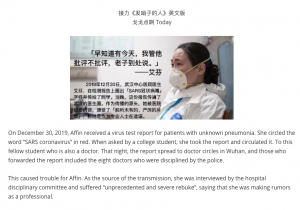Digital disobedience
来自China Digital Space
wǎngmín bù fúcóng 网民不服从

Online "performance art" campaign using translation, transcription, inversion, and other visual and typographic distortions to preserve and circulate the People (Renwu 人物) interview with Dr. Ai Fen about her censure for circulating a report on an early case of the novel coronavirus (COVID-19). Play on "civil disobedience" (gōngmín bù fúcóng 公民不服从).
The People interview, published in March 2020 as President Xi Jinping set off on his first trip to Wuhan since the outbreak, quickly disappeared from the People website and from social media. Chinese netizens are well-versed in censorship evasion techniques, such as using code words and sharing screenshots of text, but in this case a groundswell of ingenious workarounds kept the article alive.
Translations appeared in English, German, Vietnamese, Hebrew, classical Chinese, Cantonese, Sichuanese, Wu, Elvish, Klingon, and Martian script. There is a version in Braille, another in a font that mimics Mao Zedong's handwriting, another written in nucleic acid notation. There is a Star Wars version. One iteration in particular captures the spirit of digital disobedience, placing the People interview in superscript above the Baidu Baike definition of internet safety.
More from China Digital Times
<feed url="feed://chinadigitaltimes.net/china/coronavirus/feed" entries="5">
- {DATE}: [{PERMALINK} {TITLE}]
</feed>




